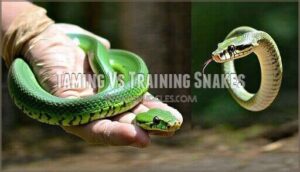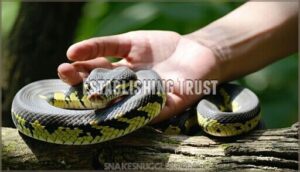This site is supported by our readers. We may earn a commission, at no cost to you, if you purchase through links.

Snakes learn through operant conditioning and positive reinforcement, responding to food rewards and consistent handling. They’ll recognize their owners, approach targets on cue, and even position themselves for veterinary exams.
Think of it as building trust rather than teaching tricks. Your snake won’t roll over or play dead, but they can master basic behaviors like station training and target touching.
The process requires patience since snakes process information differently than mammals. Success depends on understanding their limitations while respecting their natural instincts and comfort zones throughout training sessions.
Table Of Contents
Key Takeaways
- You can train your snake using positive reinforcement and operant conditioning, though they won’t learn complex tricks like mammals – focus on basic behaviors like target training and station positioning instead.
- Your snake will recognize you through scent and visual cues over time, becoming less defensive with consistent, gentle handling that builds trust rather than forcing compliance.
- Training requires exceptional patience since snakes process information differently than mammals – expect gradual progress through short, frequent sessions rather than quick results.
- Safety must come first in all training – use proper equipment like snake hooks and feeding tongs, read your snake’s body language for stress signals, and maintain emergency protocols during every session.
Can You Train a Snake?
You can absolutely train your snake using positive reinforcement and clicker training techniques.
While snake cognition differs from mammals, these reptiles demonstrate surprising behavioral adaptations through environmental enrichment.
Your snake’s instinct vs. learning balance allows for basic conditioning, though ethical considerations matter.
Snakes can also be taught to associate feeding time with specific cues, demonstrating that classical conditioning is possible.
Snake training focuses on habituation rather than complex tricks, making snake behavior modification both achievable and rewarding for dedicated owners.
Taming Vs Training Snakes
When you work with snakes, you’ll discover there’s a clear difference between taming and training these fascinating reptiles.
Taming helps your snake get comfortable with your presence and handling, while training teaches specific behaviors through consistent positive reinforcement techniques.
Taming Involves Desensitizing Snakes to Human Presence and Handling
When taming snakes, you’re basically teaching them that you’re not a threat. This process involves gradual introduction to your presence and scent acclimation through consistent interaction.
| Taming Method | Purpose | Timeline |
|---|---|---|
| Scent Acclimation | Familiarize snake with handler’s smell | 1-2 weeks |
| Hook Familiarization | Signal non-feeding interactions | Daily sessions |
| Reducing Aggression | Build trust through gentle handling | 2-4 weeks |
Snake handling techniques require patience and understanding of snake behavior patterns, which is crucial for building trust.
Training Involves Teaching Specific Behaviors Through Positive Reinforcement
Unlike desensitization, training teaches specific behaviors using positive reinforcement.
You’ll reward your snake for desired actions, building associations between cues and rewards.
Clicker training pairs sounds with treats, while verbal cues guide movement.
Through habituation training and consistent practice, snakes learn target practice and station learning basics.
| Training Method | Snake Response | Time Required |
|---|---|---|
| Clicker Training | Associates sound with reward | 2-4 weeks |
| Target Practice | Moves toward specific objects | 3-6 weeks |
| Station Learning | Remains in designated areas | 4-8 weeks |
| Verbal Cues | Responds to simple commands | 6-12 weeks |
The training methods, including clicker training, target practice, station learning, and verbal cues, are designed to help snakes learn and respond to various commands and cues.
Establishing Trust
Building trust with your snake isn’t like earning a dog’s loyalty, but it’s surprisingly achievable through consistent, gentle interactions.
You’ll need patience and slow movements since your snake won’t understand your good intentions the way a mammal would, but they can learn to recognize you as safe rather than threatening.
Slow, Gentle Handling Builds Trust Over Time
Building confidence in your snake requires patience and gentle consistency.
Handle your pet frequently but briefly, allowing recognizing progress through reduced defensive postures.
Handling frequency matters more than duration – short, calm sessions work better than lengthy encounters.
Individual differences mean some snakes adapt faster than others.
Positive reinforcement through snake handling creates lasting snake trust while reducing stress naturally.
Avoid Sudden Movements or Restraint
Since snakes startle easily, your Gentle Approach and Slow Movements are essential for successful snake handling.
Quick gestures trigger their fight-or-flight response, making them defensive.
Maintain a Calm Demeanor to Reduce Stress and Build Confidence in your pet.
For added safety, consider using specialized handling equipment during interactions.
Think of it like approaching a sleeping cat—patience wins over haste every time in snake behavior management.
Offer Food Rewards During Handling
Food rewards during handling create powerful positive associations that reduce aggression and build trust.
Smart reward timing helps your snake connect good things with human interaction, making future sessions smoother.
- Choose appropriate treats: Offer smaller prey items or favorite foods during handling sessions
- Time rewards carefully: Give treats immediately after calm behavior to reinforce positive snake behavior
- Maintain dietary variety: Rotate different food types to keep your snake engaged and motivated
Operant Conditioning
You can actually teach your snake simple behaviors using operant conditioning, which is the same method dog trainers use to reward good behavior.
When you consistently reward your snake with food or gentle handling after it displays calm behavior, it learns to associate these actions with positive outcomes and will repeat them more often, using a technique that is based on reward.
Use Positive Reinforcement to Shape Desired Behaviors
Positive reinforcement works like a charm with snakes.
You’ll use clicker training snakes and treat variety to encourage good behavior.
Shaping methods involve rewarding small steps toward your goal.
Reinforcement schedules determine when you give treats – consistency beats perfection.
Snake behavior modification happens gradually through snake training methods that build behavior chains linking actions to rewards.
Reward Snakes for Approaching, Touching, or Remaining Still
When your snake approaches your hand or remains calm during handling, immediately offer a food reward to create positive association.
Clicker introduction can mark the exact moment of desired behavior, making food motivation more effective. Focus on shaping stillness first – reward any calm response before expecting movement.
Notably, many people have negative preconceptions about snakes.
This snake behavior modification through positive reinforcement builds trust while establishing clear communication patterns between you and your reptile.
Gradually Increase Complexity of Behaviors
Building on simple rewards, behavioral shaping lets you advance your snake’s abilities through incremental steps. Think of it like teaching a child to ride a bike—you don’t start with tricks!
Advanced training involves task sequencing where you layer new behaviors onto mastered ones. Snake conditioning works best when you break complex actions into bite-sized pieces.
- Target touching before movement commands
- Short holds before extended positioning
- Simple obstacles before complex mazes
- Single cues before combination signals
Snake learning happens through consistent snake responses to specific snake stimuli, making patience your best training tool.
Target Training
You can teach your snake to move toward specific objects or locations using target training, which works like a reptilian GPS system.
This technique helps you direct your snake’s movement during handling, cleaning, or veterinary visits without stress.
Useful for Directing Movement and Positioning
Through target practice, you’ll guide your snake’s movement with precision and purpose.
Hold a target stick near desired locations—carriers, platforms, or specific enclosure design spots. Your snake learns to follow the target, making safe handling effortless during cleanings or vet visits.
This snake training method beats redirecting strikes while building trust through consistent snake responses to your gentle commands.
This approach is similar to using operant conditioning to train relocation.
Can Be Combined With Station Training
Combining these two methods creates a powerful one-two punch for snake training.
You’ll guide your snake to specific spots using targets, then teach them to stay put through station training.
This combo works brilliantly for veterinary procedures, photography sessions, and educational demos.
The enhanced cooperation reduces stress while improving safe handling during routine care or snake tricks demonstrations.
A calm environment is key, and consistent routines matter.
This approach emphasizes the importance of creating a peaceful atmosphere for effective snake handling.
Station Training
You can teach your snake to move to specific spots in its enclosure through station training, which proves surprisingly useful for vet visits and photo sessions.
This technique requires consistent practice and patience, but it’ll make handling your snake much easier when you need to examine or relocate it.
Useful for Veterinary Procedures or Photo Shoots
Veterinary procedures become manageable when your snake masters station training for safe handling.
You’ll find photo shoot posing easier as trained snakes remain calm during medication delivery and wound inspection sessions.
This snake training technique transforms stressful veterinary restraint into routine cooperation.
Your snake’s obedience during positioning allows handlers to work efficiently while maintaining snake calmness throughout examinations and photography.
Requires Patience and Consistency
Station training isn’t a sprint—it’s a marathon that rewards your gentle approach and consistent interaction.
Gradual progression through reptile training builds your snake’s confidence naturally. Habit formation occurs through daily practice, not rushed sessions.
Snake training patience means celebrating tiny victories while maintaining steady routines. Your consistency in training creates the foundation for successful animal training outcomes.
Different species require unique handling requirements, so research is key.
Recognizing Cues
You might be surprised to learn that your snake can actually recognize you and adapt to your daily routines over time.
Through repeated interactions, snakes develop the ability to distinguish their owners from strangers and anticipate regular activities like feeding times or cage cleanings, which helps them recognize and respond to their environment in a more predictable manner, and also to anticipate regular events.
Snakes Can Learn to Recognize Their Owners
Your snake can actually recognize you through scent recognition and visual cues.
Through habituation training, they learn your smell, voice patterns, and movements.
This snake recognition ability shows real bonding potential – each snake has individual personalities that respond differently to trust-building with snakes.
Regular interaction helps develop this remarkable snake intelligence, creating genuine connection between species.
Adapt to Routines and Activities
Your snake’s ability to recognize you opens the door to establishing predictable patterns.
Your snake isn’t just a pet—it’s a surprisingly intelligent companion that can learn to trust and respond to you.
Through routine establishment, your pet learns what to expect during different activities. This snake adaptation reduces stress while making the snake training process more effective.
- Consistent Schedules help your snake anticipate feeding and handling times
- Environmental Enrichment through varied activities keeps routines interesting
- Handling Frequency should remain steady for ideal snake training results
- Dietary Adjustments become easier when incorporated into established snake routines
Limitations and Considerations
While you can teach your snake basic behaviors, you’ll need to manage your expectations since they can’t learn complex tricks like your dog fetching slippers.
Their smaller brains mean you’ll need extra patience and consistent practice, but don’t worry—even small wins feel pretty rewarding when you’re working with a reptile that thinks mainly about food and safety.
Training Requires Regular Interaction and Patience
While snakes recognize familiar faces, snake training demands unwavering patience rewards.
Consistent handling and high interaction frequency accelerate habit formation and building trust.
Don’t expect overnight miracles—snake repetition creates lasting behavioral changes.
Your snake training patience during daily sessions strengthens your bond.
Regular snake interaction teaches them you’re not a threat, making each handling experience smoother and more enjoyable for both of you.
Snakes Have Limited Cognitive Abilities Compared to Mammals
Understanding your snake’s cognitive limitations helps set realistic training expectations.
While mammals possess complex brains with advanced learning centers, snake brains operate differently.
Recent cognitive research reveals surprising truths about snake training reality:
- Brain Size doesn’t determine all capabilities – snakes show spatial learning skills despite smaller neural structures
- Instinct vs. Learning – most behaviors stem from hardwired responses rather than conscious decisions
- Behavioral Complexity varies dramatically between species, challenging common snake training misconceptions
- Limited Memory affects retention of learned behaviors over time
Don’t let these snake cognitive abilities discourage you.
Understanding snake training limitations actually improves your success rate when working with these fascinating reptiles.
Safety First
Before you attempt any snake training, you’ll need to prioritize your safety and your snake’s well-being above all else.
Working with snakes requires proper equipment like hooks and secure enclosures, plus a solid understanding of your snake’s behavior patterns to prevent bites or stress.
Always Prioritize Safety When Handling and Training Snakes
Your safety matters more than any training goal when working with snakes.
Safe Handling starts with reading your snake’s body language—watch for defensive postures, hissing, or coiled positions that signal stress. Bite Prevention requires slow, deliberate movements and proper support techniques.
Establish Emergency Protocols before handling any snake, especially Venomous Species. Keep First Aid supplies nearby and know basic wound care.
Even docile snakes can bite unexpectedly, so respect their wild nature. Snake safety isn’t negotiable—one moment of carelessness can lead to serious injuries requiring immediate medical attention.
Use Appropriate Equipment and Techniques
Proper equipment makes all the difference when handling snakes safely.
You’ll want to invest in quality tools that protect both you and your serpentine friend during training sessions.
Essential snake training equipment includes:
- Snake hooks in appropriate sizes for your species
- Feeding tongs to maintain safe distance during meals
- Protective gloves designed for reptile handling.
These handling tools guarantee your snake training techniques remain both effective and secure.
Many handlers utilize specialized reptile tools for enhanced safety.
Frequently Asked Questions (FAQs)
Where to watch Snakes on a train?
Streaming, renting, or buying—you’ve got options.
You can stream "Snakes on a Plane" through various platforms like Amazon Prime, Netflix, or Hulu.
Check your local streaming services, rent digitally, or grab the DVD.
How to train your dog to avoid snakes?
You’ll want to use snake-proofing training with positive reinforcement. Teach "leave it" commands, practice recall training, and consider professional snake-avoidance classes. Keep your dog leashed in snake-prone areas for safety.
When did Snakes on a train come out?
You’ll find "Snakes on a Train" hit theaters in August
This B-movie thriller rode the wave of "Snakes on a Plane’s" popularity, offering low-budget scares with serpents terrorizing passengers aboard a cursed locomotive journey, providing complete concepts of the movie’s plot.
What is train snake?
Like a puzzle with missing pieces, "train snake" isn’t a standard term in herpetology.
You’re likely thinking of snake training techniques—teaching your serpent basic behaviors through consistent handling, hook training, and positive reinforcement methods.
Are snakes easy to train?
Snakes aren’t easy to train compared to mammals.
You can’t teach them tricks or commands due to their limited brain structure.
However, you can condition them through habituation and positive associations with patience.
How can you train a snake?
You can’t teach snakes complex tricks like dogs, but you’ll succeed with basic conditioning.
Use hook training before handling, maintain consistent feeding schedules, and practice gentle interactions to reduce defensive behaviors and build trust.
Reduce defensive behaviors and build trust by following these steps consistently.
Can snakes be trained to be friendly?
You can’t train snakes to be "friendly" like dogs, but they’ll become less defensive with consistent, gentle handling.
Regular interaction helps them recognize you’re not a threat, making them calmer and more tolerant.
Can you train a snake to like you?
Can you build a bond with a scaly companion?
You can’t train snakes to genuinely "like" you, but they’ll become comfortable through consistent handling and recognize you’re not a threat, creating trust-based familiarity instead.
Can snakes be tamed?
Yes, you can tame snakes through consistent handling and patience.
They’ll gradually become accustomed to your presence and touch, reducing defensive behaviors.
However, they won’t develop emotional bonds like traditional pets would.
Can snakes learn their owners?
Snakes can’t truly "learn" their owners like dogs do.
However, they’ll recognize your scent and become less defensive over time.
Your snake won’t show affection, but it’ll tolerate handling better with consistent, gentle interaction.
Conclusion
Picture your snake gliding confidently toward a target, responding to your gentle cues with surprising intelligence.
While you can’t expect circus tricks, you absolutely can train a snake through patience and positive reinforcement.
These remarkable reptiles recognize their owners, learn routines, and master basic behaviors that make handling safer and veterinary care easier.
Success requires understanding their unique learning style and respecting their natural instincts.
With consistent effort, you’ll discover just how trainable these fascinating creatures truly are.
- https://psycnet.apa.org/record/1936-04977-001?doi=1
- https://link.springer.com/article/10.3758/BF03199260
- https://www.livescience.com/7551-snakes-fangs.html
- http://www.dasnr.okstate.edu/Members/sean-hubbard-40okstate.edu/snakes-are-more-scared-of-you-than-you-are-of-them
- https://www.thesprucepets.com/feeding-snakes-frozen-mice-1239476
















